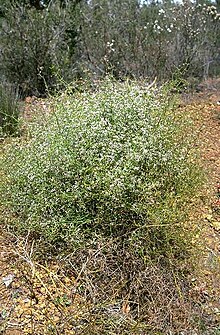Conospermum flexuosum
| Conospermum flexuosum | |
|---|---|

| |
| Scientific classification | |
| Kingdom: | Plantae |
| Clade: | Tracheophytes |
| Clade: | Angiosperms |
| Clade: | Eudicots |
| Order: | Proteales |
| Family: | Proteaceae |
| Genus: | Conospermum |
| Species: | C. flexuosum |
| Binomial name | |
| Conospermum flexuosum | |

Conospermum flexuosum, commonly known as the tangled smokebush,[2] is a species of flowering plant in the family Proteaceae and is endemic to the south-west of Western Australia. It is a sprawling shrub with many zig-zag branches, panicles of white to pale blue, tube-shaped flowers and urn-shaped, hairy nuts.
Description
Conospermum flexuosum is a sprawling shrub that typically grows to a height of up to 0.2–1.5 m (7.9 in – 4 ft 11.1 in) and has many zig-zag or winding branches. The leaves are clustered at the base of the plant, spatula-shaped, square or almost circular in cross-section, 65–240 mm (2.6–9.4 in) long and 4–17 mm (0.16–0.67 in) wide on a petiole 17–70 mm (0.67–2.76 in) long. Older plants are often leafless. The flowers are borne in branching panicles with heads of 3 to 7 flowers on the ends with brownish-blue bracteoles 1.5–2.5 mm (0.059–0.098 in) long with velvety hairs. The perianth is tube-shaped, 2.0–3.5 mm (0.079–0.138 in) long and white to pale blue with woolly white or rust-coloured hairs, the lobes 2–4 mm (0.079–0.157 in) long and 0.5–1 mm (0.020–0.039 in) wide. Flowering occurs from May to October, and the fruit is an urn-shaped nut, 2.5–3.0 mm (0.098–0.118 in) long and 1.75–2.5 mm (0.069–0.098 in) wide and covered with soft, brown, red or white hairs.[2][3]
Taxonomy
Conospermum flexuosum was first formally described in 1830 by Robert Brown in his Supplementum primum Prodromi florae Novae Hollandiae from specimens collected near King George Sound by William Baxter.[4][5] The specific epithet (flexuosum) means 'flexuose' or 'zig-zag', referring to the branching habit.[6]
Subspecies
In 1995, Eleanor Marion Bennett described two subspecies of Conospermum flexuosum in the Flora of Australia, and the names are accepted by the Australian Plant Census:
- Conospermum flexuosum R.Br. subsp. flexuosum[7] has tuberculate branches with 4 to 6 ridges, with veins between the tubercules.[8][9]
- Conospermum flexuosum subsp. laevigatum (Meisn.)E.M.Benn.[10] (previously known as Conospermum flexuosum var. laevigatum Meisn.)[11] has branches without tubercules, and 8 to 12 ribs.[12][13]
Distribution and habitat
Conospermum flexuosum is found in sand pockets among granite outcrops, on winter-wet flat areas and along roadsides in the Esperance Plains, Jarrah Forest, Swan Coastal Plain and Warren bioregions of south-west Western Australia.[2] Subspecies flexuosum occurs near Albany, south of the Stirling Range and east to Wellstead,[8][9] but subsp, laevigatum mostly occurs between Capel and Busselton, and east to Nannup.[12][13]
Conservation status
Both subspecies of C. flexuosum are listed as "not threatened" by the Government of Western Australia Department of Biodiversity, Conservation and Attractions.[9][13]
References
- ^ "Conospermum flexuosum". Australian Plant Census. Retrieved 4 August 2024.
- ^ a b c "Conospermum flexuosum". FloraBase. Western Australian Government Department of Biodiversity, Conservation and Attractions.
- ^ Bennett, Edith M. "Conospermum flexuosum". Flora of Australia. Australian Biological Resources Study, Department of Climate Change, Energy, the Environment and Water: Canberra. Retrieved 4 August 2024.
- ^ "Conospermum flexuosum". APNI. Retrieved 4 August 2024.
- ^ Brown, Robert (1830). Supplementum primum Prodromi florae Novae Hollandiae. London: Typis R. Taylor. p. 11. Retrieved 4 August 2024.
- ^ Sharr, Francis Aubi; George, Alex (2019). Western Australian Plant Names and Their Meanings (3rd ed.). Kardinya, WA: Four Gables Press. p. 200. ISBN 9780958034180.
- ^ "Conospermum flexuosum subsp. flexuosum". Australian Plant Census. Retrieved 4 August 2024.
- ^ a b Bennett, Edith M. "Conospermum flexuosum subsp. flexuosum". Flora of Australia. Australian Biological Resources Study, Department of Climate Change, Energy, the Environment and Water: Canberra. Retrieved 4 August 2024.
- ^ a b c "Conospermum flexuosum subsp. flexuosum". FloraBase. Western Australian Government Department of Biodiversity, Conservation and Attractions.
- ^ "Conospermum flexuosum subsp. laevigatum". Australian Plant Census. Retrieved 4 August 2024.
- ^ "Conospermum flexuosum var laevigatum". APNI. Retrieved 4 August 2024.
- ^ a b Bennett, Edith M. "Conospermum flexuosum subsp. laevigatum". Flora of Australia. Australian Biological Resources Study, Department of Climate Change, Energy, the Environment and Water: Canberra. Retrieved 4 August 2024.
- ^ a b c "Conospermum flexuosum subsp. laevigatum". FloraBase. Western Australian Government Department of Biodiversity, Conservation and Attractions.
